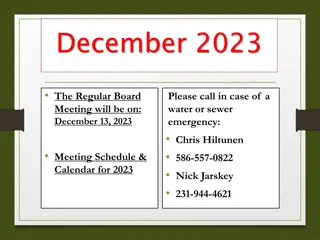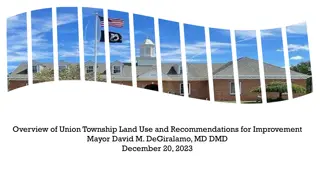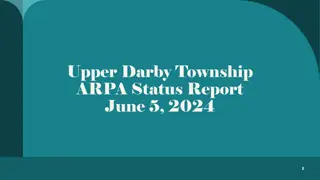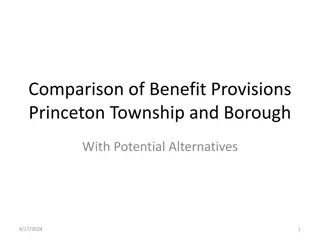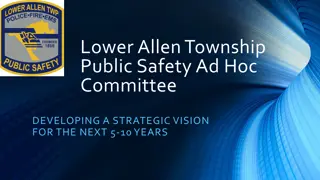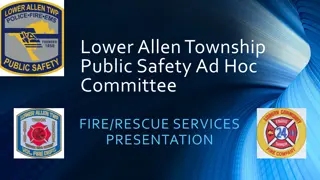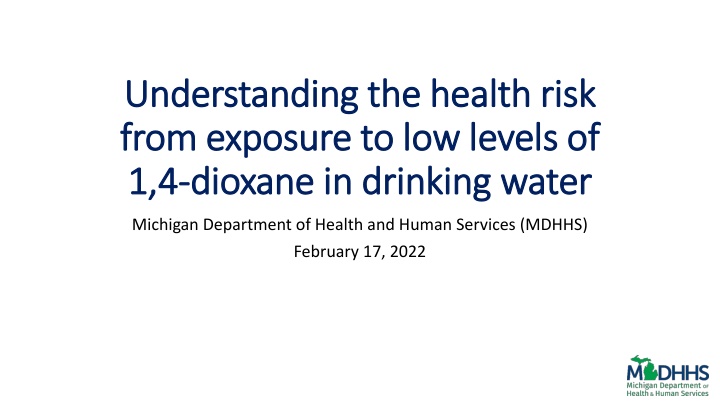
Health Risks of 1,4-Dioxane Exposure in Drinking Water
Learn about the health risks associated with exposure to low levels of 1,4-dioxane in drinking water, including screening levels, cancer risks, and noncancer health effects. Understand the EPA and EGLE criteria, as well as how to evaluate potential risks and take necessary actions. For more information and questions, contact MDHHS Division of Environmental Health.
Download Presentation

Please find below an Image/Link to download the presentation.
The content on the website is provided AS IS for your information and personal use only. It may not be sold, licensed, or shared on other websites without obtaining consent from the author. If you encounter any issues during the download, it is possible that the publisher has removed the file from their server.
You are allowed to download the files provided on this website for personal or commercial use, subject to the condition that they are used lawfully. All files are the property of their respective owners.
The content on the website is provided AS IS for your information and personal use only. It may not be sold, licensed, or shared on other websites without obtaining consent from the author.
E N D
Presentation Transcript
Understanding the health risk Understanding the health risk from exposure to low levels of from exposure to low levels of 1,4 1,4- -dioxane in drinking water dioxane in drinking water Michigan Department of Health and Human Services (MDHHS) February 17, 2022
What are screening levels? What are screening levels? Conservative values used to determine whether exposure poses a potential risk, and whether any follow up actions are needed EGLE drinking water criteria are regulatory values used for enforcement purposes. Exposure above a screening level/criteria does not necessarily mean that a person will experience health effects Based on conservative exposure assumptions Protective of the whole population, including sensitive individuals
1,4 1,4- -Dioxane EGLE drinking water criteria Dioxane EGLE drinking water criteria EGLE Age-specific drinking water exposure for 32 years out of a 78-year lifetime 1 in 100,000 cancer risk EPA EPA Measure of cancer risk in mice Review the scientific literature 7.2 ppb EPA EPA Study of liver cancer in mice exposed to 1,4- dioxane Human cancer slope factor
Cancer risk Cancer risk EPA lifetime exposure concentration EPA Regional Screening Level (RSL) EGLE Drinking Water Criteria 35 ppb 3.5 ppb 0.35 ppb 1 in 10,000 46 ppb 4.6 ppb 0.46 ppb EPA recommended maximum cancer risk range 7.2 ppb 1 in 100,000 1 in 1,000,000
Exposure to low levels of 1,4 Exposure to low levels of 1,4- -dioxane in drinking water drinking water dioxane in Noncancer health effects EPA noncarcinogenic screening level = 57 ppb Threshold below which noncancer health effects are not expected Cancer No threshold, just lower levels of risk as exposure concentration decreases Exposure below 7.2 ppb would pose a cancer risk of less than 1 in 100,000 Not intended to represent actual risk to the community 1 in 100,000 0.13 in 100,000 or 1.3 in 1,000,000 7.2 ppb 1 ppb
Questions? Questions? Please feel free to contact us if you have any questions related to 1,4- dioxane and health. MDHHS Division of Environmental Health (DEH) 1-800-648-6942



